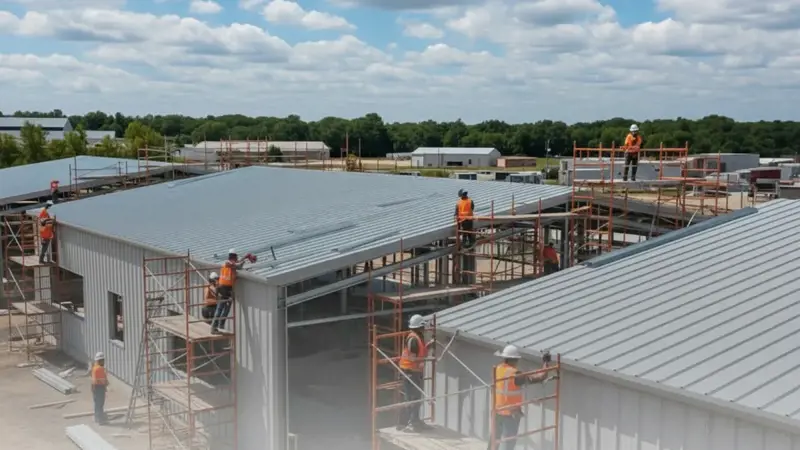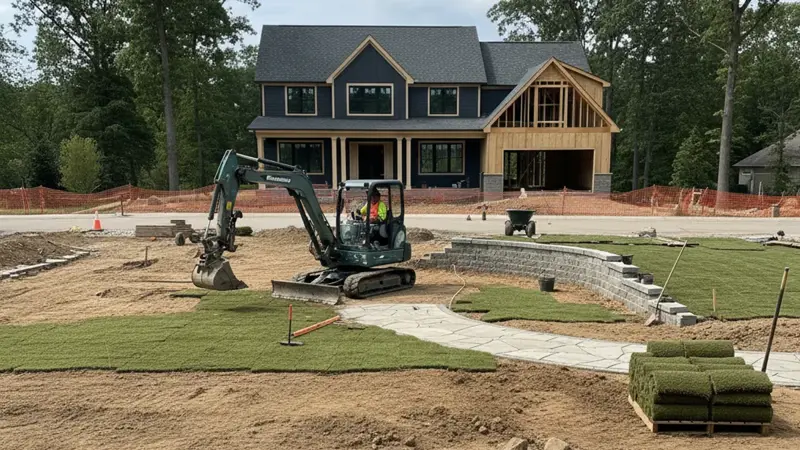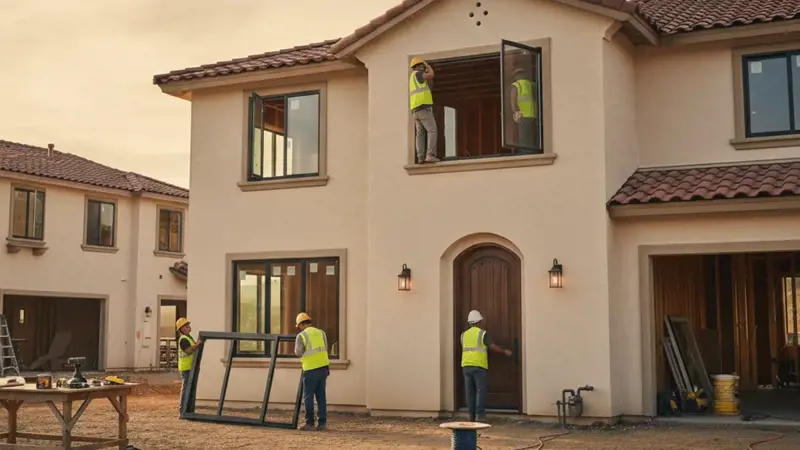Pre-engineered metal buildings (PEMBs) and steel structures are cost-effective, durable, and 100% recyclable, which makes them environmentally friendly. These characteristics make them suitable for a range of construction needs, from industrial warehouses to agricultural buildings and even sports complexes. If you are considering using this system, it is crucial to understand the cost of pre-engineered metal buildings to set a budget and plan to fulfill the project as effectively and profitably as possible. We guide you through the components of estimating these systems, as well as introducing tools that you can use as a metal building cost calculator.
Components that make up the price of a PEMB
A pre-engineered metal building is made of several components that contribute to the final cost of using this system. Understanding these factors will help you have a clear vision of where your money is going.
- Structural Frame: This is the primary structural skeleton of the building, typically composed of steel columns and beams. The element that can impact the cost here is the complexity of the frame, such as the number of bays and load requirements.
- Roof and Wall Cladding: These are exterior coverings of the building, including insulated steel panels and metal sheets. The material used, insulation levels, and additional aesthetic items can all affect the price.
- Doors and Windows: The number, size, materials, and type of doors and windows, such as overhead doors, skylights, and similar features, can significantly impact the cost.
- Foundation: The foundation is the key to a building’s stability. The type of foundation, size, soil conditions, and site preparation can impact the cost.
- Utilities: electrical, plumbing, and HVAC systems add up the costs, especially for complex projects like commercial or sports facilities
- Erection Costs: This includes labor and equipment costs as well as transportation fees. Variable factors that can affect the price include local labor costs, the complexity of the design, accessibility, and the project's height.
- Ancillary Items: Some smaller items are usually neglected while setting the budget, but can add up to a noticeable amount to the cost. These items include gutters, downspouts, trim, insulation accessories, and ventilation systems.

The Impact of Dimensions and Clear Span on Pricing
The primary factors that can determine the cost of pre-engineered metal buildings are their dimensions. In other words, understanding the impact of a project’s length, width, height, and clear span can become useful in estimation.
- Length and Width: the longer the building is, the longer the framing requires; it means that you will need more materials and a larger foundation
- Higher buildings require longer columns and often deeper excavation. These issues can impact the cost as they need more equipment.
- Clear span: A clear span refers to the unobstructed interior space without internal columns or obstructions. Such buildings require stronger and more complex framing to support the roof, which will significantly increase the final cost.
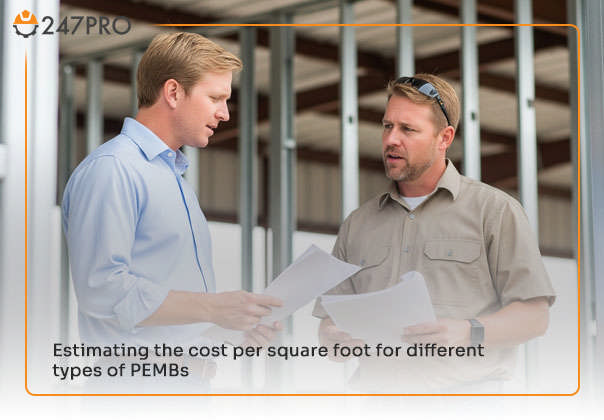
Estimating the cost per square foot for different types of PEMBs
Estimating the cost of a pre-engineered metal building per square foot is a common metric for setting the budget; however, it is essential to remember that this price is an average, and the final cost can vary significantly based on your building’s specific characteristics and needs. On average, pre-engineered metal building costs range from 10 to $50 per square foot, depending on the building type and specifications.
Here is a general look at the typical cost per square foot range for PEMBs based on their type in the San Francisco market. The cost includes installed and finished prices, as well as PEMB kits, erection, foundation, utilities, and standard interior finishes.
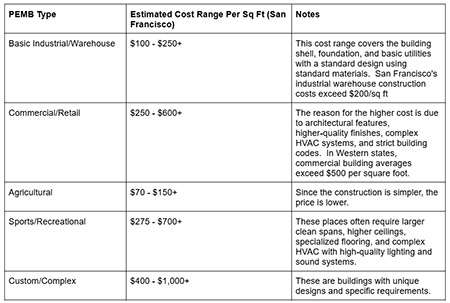
These numbers are estimated based on the average construction costs in San Francisco and PEMB prices. The actual project cost will vary based on your location, specific designs, site conditions, local labor costs, and real-time market variations.
How to Estimate PEMB Costs
Estimating the cost of Pre-Engineered Metal Buildings requires a systematic breakdown of the project.
- Define requirements: specify elements such as building usage, exact dimensions, any desired features, and other specific load requirements.
- Square Footage Calculation: calculate the approximate, if possible, the exact square footage of your building. This is the very first point for applying the average square per foot ranges.
- Customization: Always consider a portion of your budget for any custom features that are not among the standard requirements of the project.
- Factor in Foundation Costs: Foundation costs are not always the same and are highly site-specific. Dedicate approximately $4 to $10+ per square foot for a basic slab-on-grade foundation, but bear in mind that soil condition and the design can change this number.
- Estimate Erection Costs: This typically accounts for 30% to 60% of the base PEMB kit price, but may vary depending on location and complexity.
- Don’t Overlook Utilities and Ancillary Components: Set aside a portion of your budget for operating electrical, plumbing, and HVAC systems. It is recommended to get quotes from different local contractors for these aspects.
- Consider unexpected issues: In any construction project, some unexpected issues can arise. It is wise to put a 5–10% contingency in your total budget to cover these expenses.
Introduction to estimation methods
You can always obtain a detailed quote from PEMB suppliers; however, you can also use different services to estimate the cost of pre-engineered metal buildings yourself.
- Advanced Excel Formulas and Spreadsheets: If you are a spreadsheet person, you can create an estimation sheet by listing the components of the project, researching average material and labor costs in your area, and using formulas to calculate total project cost.
- Online Metal Building Cost Calculators: For more accurate and streamlined estimation, you can use an online metal building cost calculator to get the exact cost of your project. This service goes beyond simple calculation and offers:
- Template-Based Efficiency
- Customizable Local Costs
- Professional Proposal Generation
- Other professional tools to manage projects
By using these tools, whether a manual spreadsheet or an online tool, you can obtain a detailed and accurate estimate to inform your decision about the project you have in mind

A checklist of commonly overlooked factors in initial estimates
To avoid any budget surprises, always keep these factors in mind:
- Find out what mandatory permits you need and how much it would cost to get them
- Examine your site’s condition and consider the costs associated with clearing the site, grading, erosion control, and any necessary demolition.
- Consider delivery fees, as shipping large steel components to a remote site can be extremely costly.
- Higher insulation might seem costly, but it can save on utilities in the long term.
- Consider the proper disposal of construction debris.
By carefully considering these factors, you can set a more realistic budget for a pre-engineered metal building project.
